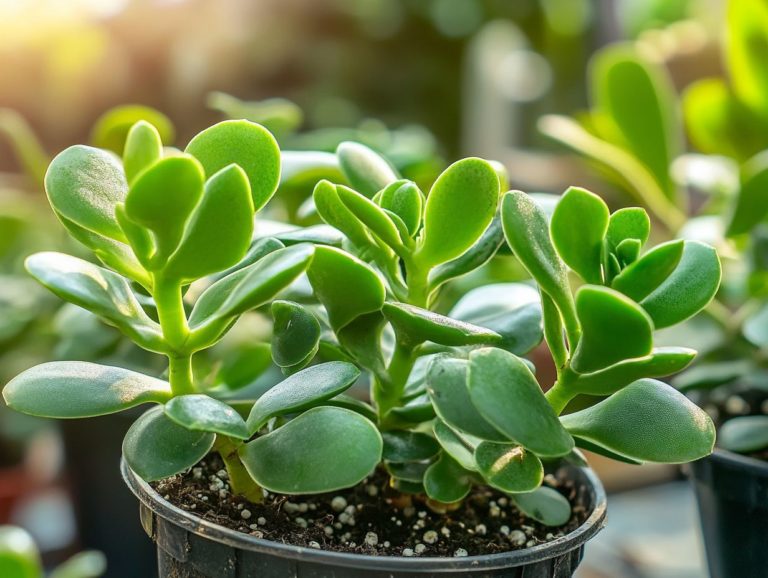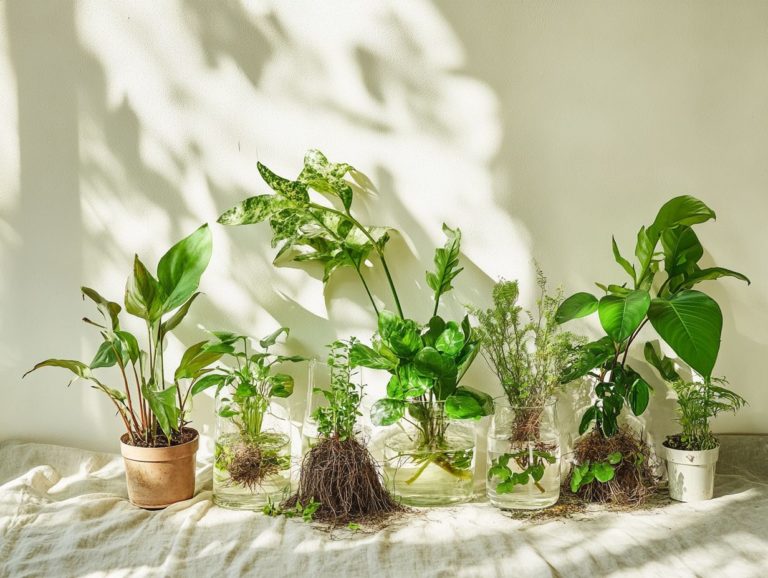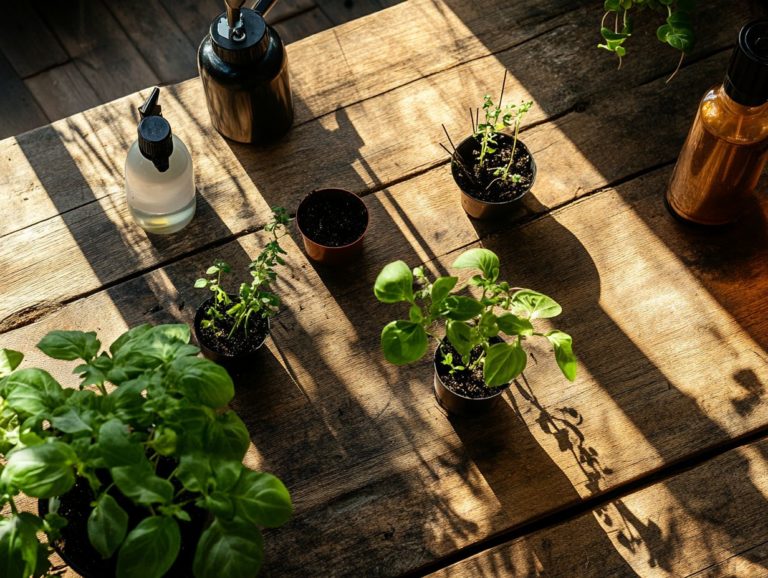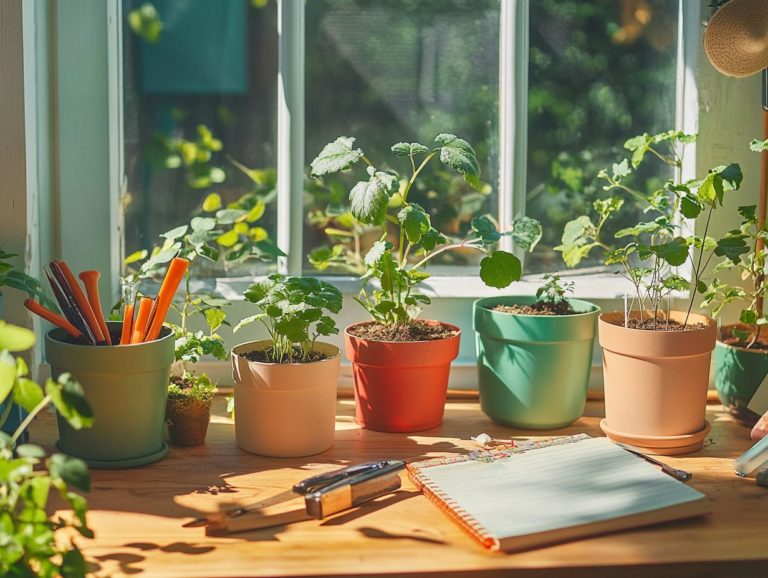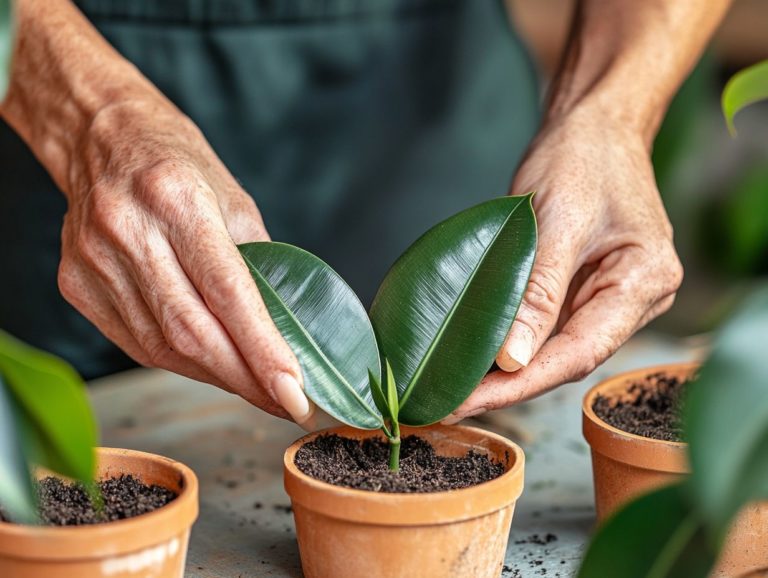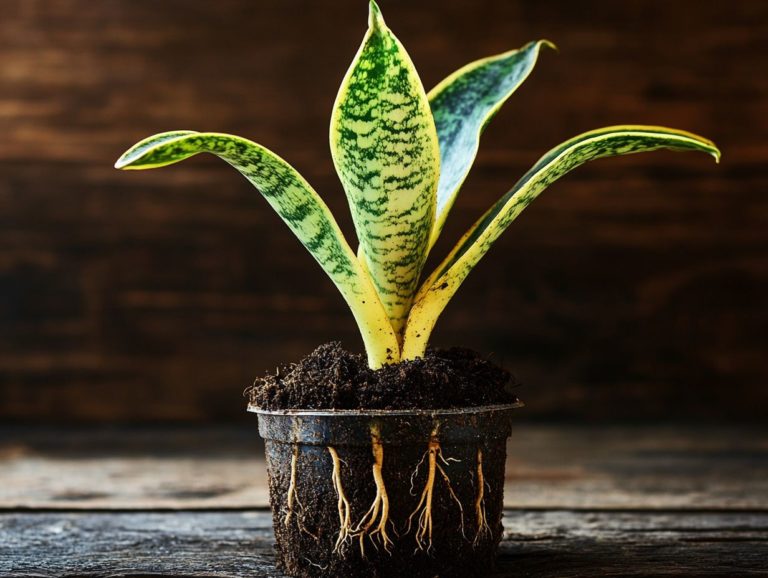How to Propagate Indoor Ferns
Indoor ferns make stunning additions to your home. They are surprisingly easy to propagate, giving you the opportunity to expand your collection or share the beauty with friends by growing new ferns.
This article delves into the fascinating realm of fern propagation. It highlights common varieties and their distinctive traits. You ll learn various ways to grow new ferns, such as division, fern spores, and offsets.
You ll discover a comprehensive guide outlining the necessary tools and step-by-step instructions. Valuable tips to troubleshoot common issues that may arise are also included.
Let s embark on this journey to nurture these lush greens together. We will ensure a strong focus on plant care.
Contents
- Key Takeaways:
- Types of Indoor Ferns
- Methods of Propagation
- Supplies Needed for Propagation
- Step-by-Step Guide to Propagating Indoor Ferns
- Choosing a Propagation Method
- Caring for Newly Propagated Ferns
- Troubleshooting Common Issues
- Frequently Asked Questions
- What is propagation and why is it important for indoor ferns?
- What is the best time of year to propagate indoor ferns?
- What are the different methods for propagating indoor ferns?
- How do I propagate indoor ferns through division?
- Can I propagate indoor ferns in water?
- What is the most important thing to remember when propagating indoor ferns?
Key Takeaways:

- Indoor ferns can be propagated through division, spores, or offsets.
- Proper care and preparation of the fern are crucial for successful propagation.
- Identifying and addressing common issues like pests and diseases can ensure the health of newly propagated ferns.
What is Propagation?
Propagation is the art of creating new plants from existing ones. When diving into the world of ferns, you’ll discover a variety of methods that yield vibrant, thriving specimens. Grasping the nuances of fern anatomy like their sporangia (the spore-producing part of the fern) and fronds is essential for mastering effective plant care and propagation techniques.
Understanding the optimal growing conditions, such as high humidity, indirect light, and fertile soil, can significantly enhance your success rate. You can cultivate lush, healthy leaves this way.
Exploring propagation brings joy as you nurture new life. You also elevate the visual appeal and biodiversity of your garden. Ferns, with their distinctive reproductive structures, flourish in environments that mirror their natural habitats. Recognizing and meeting their specific needs is crucial.
For example, leveraging moisture-loving spores and the ability to produce offsets can greatly streamline your efforts in developing new specimens.
Each method you choose whether division, spore germination, or tissue culture underscores the importance of patience and care. It reflects the delicate balance between nature and cultivation on your gardening journey.
Types of Indoor Ferns
Indoor ferns offer a stunning array of species. The Boston fern stands out as one of the most beloved choices due to its rich greenery and versatility in indoor settings.
These ferns flourish in high humidity and thrive under carefully managed ambient temperatures. They make perfect companions for your indoor gardening endeavors, especially when using organic compost.
Understanding the unique requirements of various indoor fern types promotes robust growth and elevates the visual charm of your living spaces, especially with the proper soil type.
Common Varieties and Characteristics
Common varieties of indoor ferns, such as Boston ferns, Adiantum, Dryopteris, and Asplenium, each bring their own flair to your gardening experience. Grasping the unique characteristics of these fern species such as their frond shapes, growth habits, and light preferences is crucial for effective propagation and plant care. This insight allows you to choose the right ferns for your specific growing conditions, ensuring your indoor plant collection thrives.
Take the Boston fern, for example. Its lush, arching fronds can turn any room into a vibrant oasis. It flourishes best in indirect sunlight and a humid environment. Plus, it s a natural air purifier, making it even more appealing.
Then there s Adiantum, also known as maidenhair fern. This beauty, with its delicate, lace-like leaves, prefers low light and consistent moisture. It makes a perfect fit for bathrooms or cozy, shaded corners.
On the other hand, Dryopteris, or the male fern, showcases dark green foliage that can tolerate drier conditions. Meanwhile, Asplenium, commonly referred to as the bird’s nest fern, delights with its wavy fronds and thrives in lower light situations. It benefits greatly from careful pruning of the fronds.
Each of these ferns comes with its own tailored propagation techniques. From division to spore harvesting, these methods enhance your expertise and success in cultivating a flourishing fern collection.
Methods of Propagation
You can explore several effective methods of fern propagation, including root divisions, spore harvesting, and offsets. Each method suits various fern species and gardening preferences, ensuring optimal growth.
Each technique has unique advantages and challenges. Understanding the details of fern propagation is crucial for your success in growing these beautiful plants. By using clean tools and maintaining high humidity, you significantly increase your chances of successful propagation. For those interested in expanding their plant collection, consider learning how to propagate indoor plants from seeds.
Division
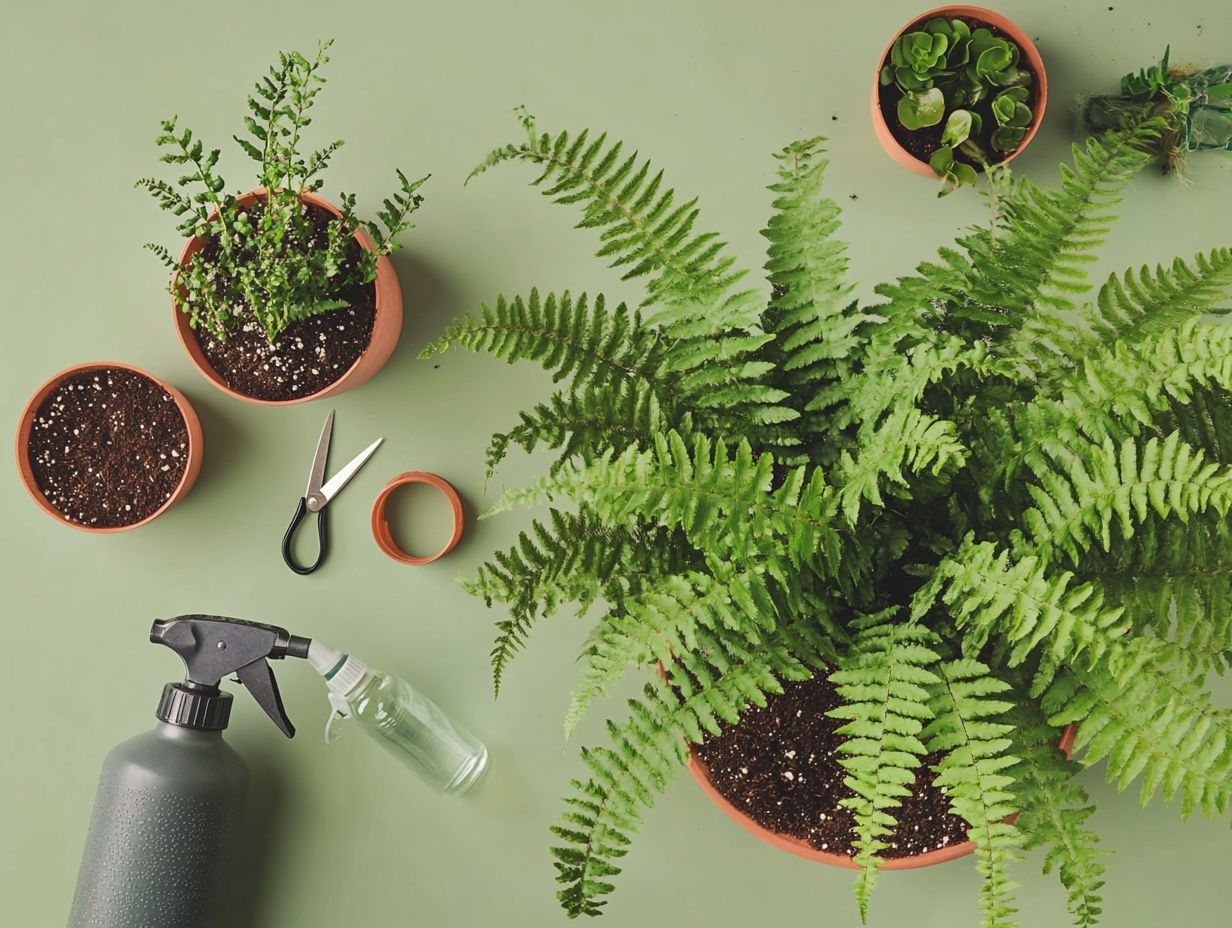
Division is a simple way to multiply your ferns. You can turn one mature fern into several healthy plants using underground stems or offsets. This technique works particularly well for ferns that naturally produce rhizomes, ensuring each part has a viable root system for robust growth.
To make this method work for you, focus on proper plant care. Pay attention to soil type, moisture retention, and maintaining a humid atmosphere.
To start the division process, gently remove the parent fern from its pot and shake off any excess soil to reveal the roots. Look for natural separations in the rhizome where the fern can be easily divided.
With a sharp, clean knife or shear, cut the rhizome into sections, ensuring each piece has a healthy cluster of roots. After dividing, place the sections in a well-draining potting mix that retains moisture while allowing airflow. Peat-based blends with added perlite or organic compost work wonders.
Once you’ve repotted the sections, keep them in a shaded area. Monitor moisture levels closely to avoid overwatering, which can lead to root rot. For optimal results, refer to this guide on how to successfully care for indoor ferns. With attentive care and a bit of patience, you’ll be amazed at how quickly your new ferns can grow!
Spores
Using fern spores for propagation offers a unique opportunity to engage with the intricate life cycle of these fascinating plants. You ll appreciate the vital role spore-producing parts play in their reproduction.
Timing is key when collecting spores. This method is both rewarding and captivating. Nurture the spores in sterilized containers filled with a suitable peat mixture or sterile soil, and watch the magical transformation into new fern plants.
Mastering the art of harvesting and storing spores is essential for your success. Wait until the spores turn brown and are easily released from the sporangia; that s your cue for collection. Use parchment paper to minimize contamination risks during this process.
For storage, keep the spores in a cool, dry place to maintain long-term viability and preserve their germination potential.
Creating the ideal environment for growing ferns from spores involves maintaining a consistently humid atmosphere, providing suitable light levels, and offering proper care. Each of these factors can significantly influence the sprouting of your new plants, ensuring they thrive beautifully in your home.
Offsets
Offsets are little plantlets that sprout at the base of mature ferns. They provide a simple way to propagate ferns.
This method allows you to cultivate new plants with minimal effort. Remove the offsets with their roots and replant them in fresh potting soil or a peat mix that holds moisture well. To help your new plants thrive, create a humid environment and keep a consistent watering schedule!
To spot suitable offsets, look for small, healthy plantlets with visible root systems at the base of the parent fern. Once identified, dig carefully to avoid damaging the offsets or the mother plant. After gently separating the plantlets, use clean, sharp tools for effective propagation of monstera plants.
When you repot, opt for a well-draining potting mix to promote robust root development. During the early stages, pay close attention to moisture levels and provide indirect light. To enhance your plant care, consider learning how to propagate your favorite houseplants. This will encourage vigorous growth, allowing your ferns to thrive beautifully over time while using balanced fertilizer.
Supplies Needed for Propagation
Successful fern propagation hinges on a few essential supplies: clean tools, fresh potting soil, sterilized containers, and, if desired, a splash of liquid fertilizer or organic compost.
Keeping your tools pristine reduces the risk of pest issues and fosters robust plant development. Choosing the right potting soil, like a moisture-retentive peat mix, is vital for the overall health of your propagated ferns.
Essential Tools and Materials for Propagation
The right tools and materials are essential for plant care during fern propagation. Gather sharp, clean tools for pruning and dividing ferns, along with sterilized containers to keep diseases at bay. Fresh potting soil is a must, providing the nutrients and moisture retention your ferns crave.
A fine mist spray bottle can be your best friend in maintaining optimal humidity, which is critical for ferns, especially in those early growth stages. Keep all your tools sanitized; regular cleaning with a sterile solution prevents cross-contamination and promotes the health of your propagated plants. Creating a humid atmosphere is essential for their well-being.
Using labels to mark different fern varieties is a smart move! It helps you track their progress and care routines. By following these best practices along with garden tips, you’ll cultivate a thriving environment for your ferns, enhancing both their growth and the propagation process.
Step-by-Step Guide to Propagating Indoor Ferns
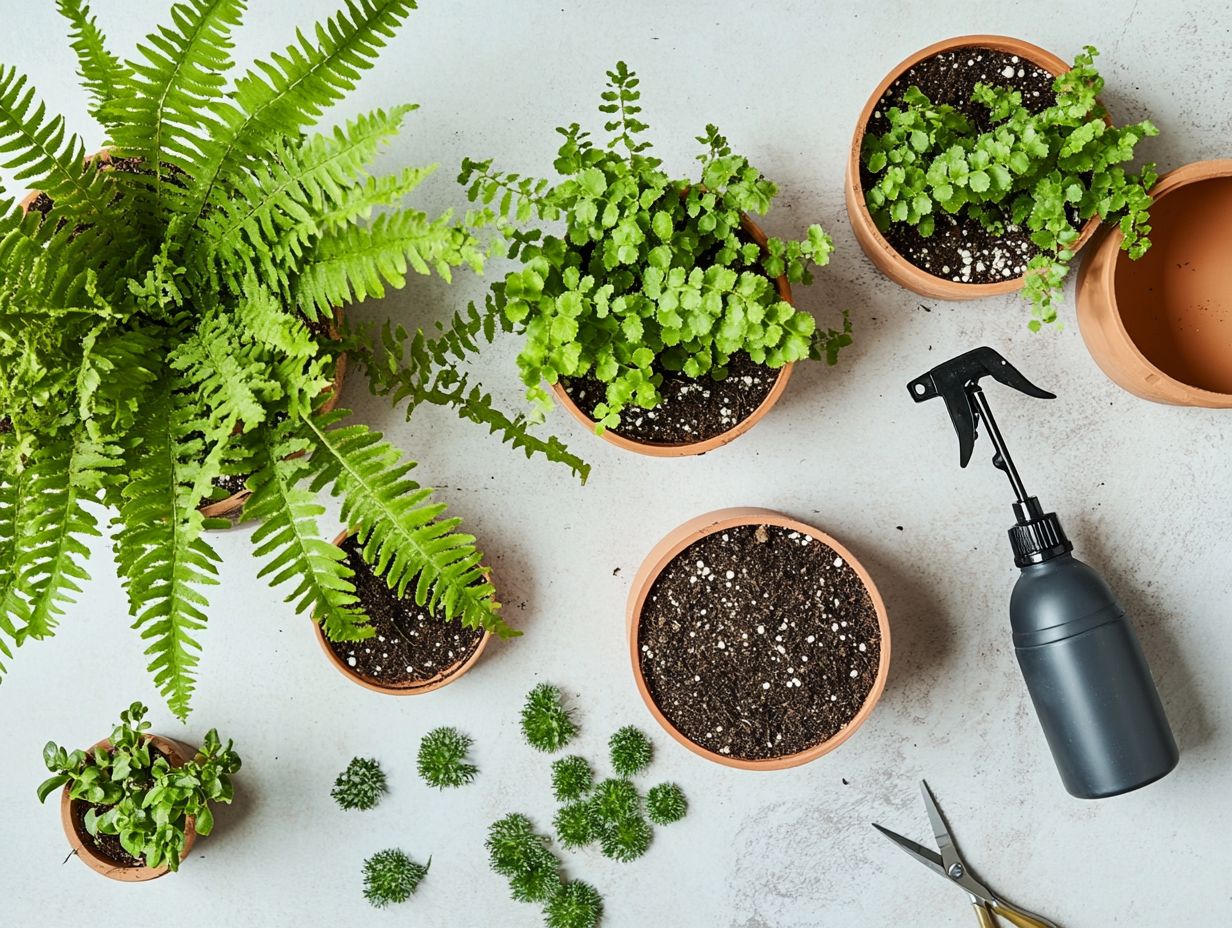
A step-by-step guide to propagating indoor ferns involves several essential stages. This ensures you’re well-equipped for the process and fully aware of the care required for your newly propagated ferns.
From selecting the ideal propagation method to creating the perfect environment, each step plays a pivotal role in promoting their growth and vitality. By following these guidelines, you’ll cultivate thriving ferns that will enhance your indoor spaces beautifully.
Preparing the Fern
Preparing your fern for propagation is vital. Start by pruning fronds and ensuring your plant is healthy and well-maintained.
To boost the chances of successful propagation, inspect your fern for any pests or diseases. Evaluate the overall vigor and appearance of the plant. Effective pruning is essential; remove any dead or damaged fronds to promote new growth and channel energy needed for rooting. Additionally, understanding proper watering techniques for ferns can greatly enhance your plant care efforts.
Establish the right conditions by considering humidity levels, light exposure, and ambient temperature. Using the right liquid fertilizer will significantly increase the likelihood of your newly propagated plants thriving, and you can learn how to propagate indoor plants with minimal effort, setting the stage for a lush and flourishing fern collection.
Choosing a Propagation Method
Choosing the right propagation method the way you grow new plants from existing ones is essential for your success in growing ferns. Different species may respond better to techniques like division, spores, or offsets.
By understanding the unique characteristics of each fern species, such as the Boston Fern, along with the ideal growing conditions, you can select the most effective propagation method, including how to propagate spider plants. This informed choice significantly increases your chances of nurturing healthy, thriving plants.
Take, for example, the beloved Boston Fern. It s often best propagated through root divisions. This technique allows you to create multiple plants from a single mother specimen.
If you’re considering spore propagation, the delicate maidenhair fern may be your ideal candidate. This method presents a more natural approach to cultivating these exquisite plants.
When determining the best method, consider factors such as your available space, resources, and growth ambitions. Additionally, the climate and humidity levels play a crucial role in the success of your chosen techniques.
Familiarize yourself with the specific requirements of the fern species you wish to cultivate. Pay attention to factors like sunlight exposure and soil type.
Caring for Newly Propagated Ferns
Caring for your newly propagated ferns is essential for their establishment and growth. This requires your attention to a consistent watering schedule and creating a humid atmosphere to meet their needs.
Use a balanced fertilizer to help your ferns grow strong. This will provide essential nutrients, promoting the development of healthy leaves and robust plant structures.
Using organic compost can also enhance the fertile soil and nutrient availability. By ensuring these conditions, you can accelerate the growth of your newly propagated ferns.
Water your ferns thoroughly while allowing any excess water to drain away. Aim for a humidity level of around 60% to 80%, which you can achieve through misting or by using a pebble tray filled with water.
As a new plant caretaker, you might encounter challenges like leaf browning or wilting. These issues are typically linked to improper watering or humidity levels.
By closely monitoring environmental conditions and adjusting your care routines, you’ll create the ideal setting for your ferns to flourish. Don t miss out on ensuring your ferns thrive!
Employing moisture meters can help you achieve the right levels of care.
Troubleshooting Common Issues
Troubleshooting common issues in fern propagation requires you to identify and address potential problems. These may include pests, diseases, or unfavorable growing conditions that can impede plant health.
Regularly check for signs of leaf browning. By understanding the specific needs of various fern species, you can quickly diagnose issues and implement necessary solutions.
Taking a proactive approach to pest control and care routines enables you to cultivate thriving plants, even in challenging environments. Explore more tips to keep your ferns flourishing!
Identifying and Addressing Problems
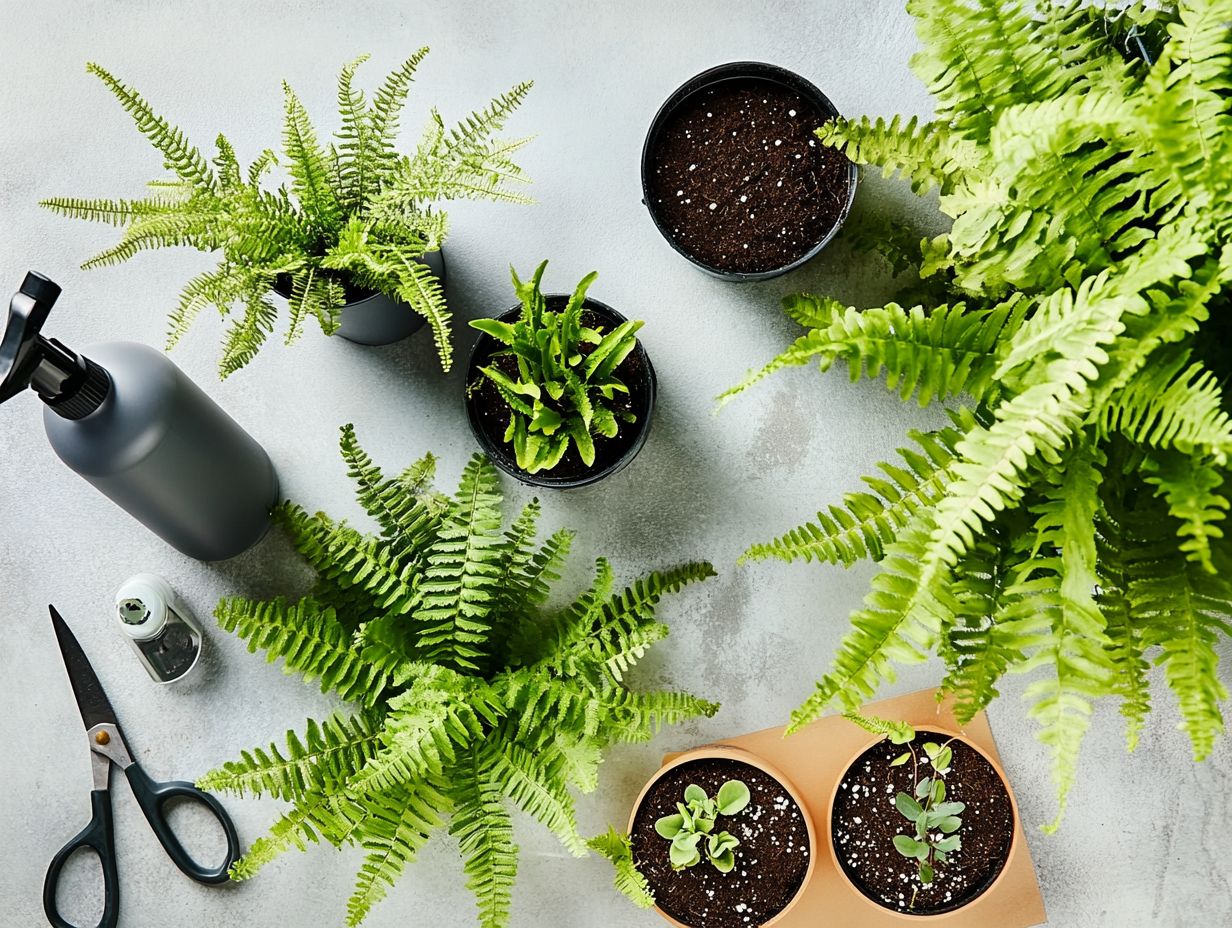
Identifying and addressing issues that could impact fern health is essential for successful propagation and growth. Many problems stem from improper care or unfavorable environmental conditions.
Regularly checking your moisture meter will help you maintain consistent watering. Keeping an eye out for signs of pests is crucial in preserving your ferns overall health. Understanding fern anatomy helps diagnose various issues effectively. Act now to tackle issues before they escalate, ensuring your ferns thrive.
Plus moisture levels and observing the foliage for discoloration, wilting, or unusual spots can alert you to potential stress or disease. Common pests like aphids or spider mites might reveal themselves through webs or sticky residues on the leaves.
Consider using natural methods to control pests, like bringing in helpful insects or using safe sprays. Regular spore harvesting can also help maintain a healthy fern garden.
For diseases, ensure proper air circulation and avoid overhead watering to help stave off fungal growth. By fostering healthy soil, perhaps by adding organic compost, and ensuring appropriate lighting conditions, you’ll create an environment that addresses existing problems and fortifies your ferns against future threats. For beginners looking to enhance their indoor gardening experience, check out the best indoor ferns that are easy to care for.
For a deeper educational experience, check out our related videos on growing ferns and plant care.
Frequently Asked Questions
What is propagation and why is it important for indoor ferns?
Propagation is the process of creating new plants from existing ones, including techniques like spore harvesting and plantlets. It’s important for indoor ferns because it allows you to expand your collection and keep your ferns healthy and thriving.
What is the best time of year to propagate indoor ferns?
The best time to propagate indoor ferns is in the spring or summer when the plant is actively growing. This will give the new plant the best chance of success, especially under conditions of high humidity.
What are the different methods for propagating indoor ferns?
There are several methods to propagate indoor ferns, including division, spore propagation, and plantlets. Each of these propagation methods has its own benefits and success rate, so it’s best to try a few and see what works best for you.
How do I propagate indoor ferns through division?
To propagate through division, carefully remove the fern from its pot and gently separate the root ball into smaller sections with a clean knife. Make sure each section has some healthy fern fronds and roots. Plant the divisions in their own pots with fresh soil and water thoroughly, ensuring the right moisture retention.
Can I propagate indoor ferns in water?
Yes, some ferns can be propagated in water by taking a cutting with at least 2-3 leaf clippings and placing it in a jar of clean water. Change the water every few days and wait for roots to form before transplanting into soil.
What is the most important thing to remember when propagating indoor ferns?
The most important thing to remember when propagating indoor ferns is to use clean tools and pots to prevent the spread of diseases. It’s also crucial to give the new plant proper care and attention to ensure its successful growth.

